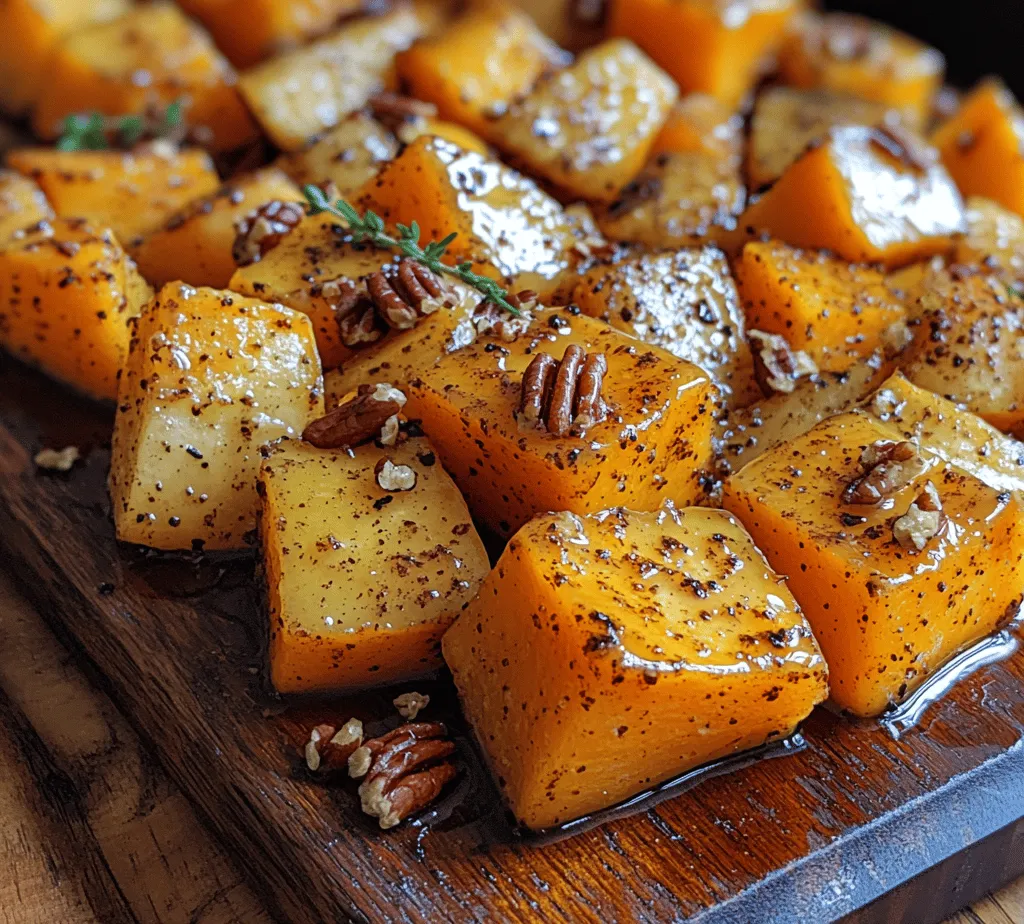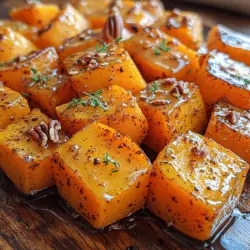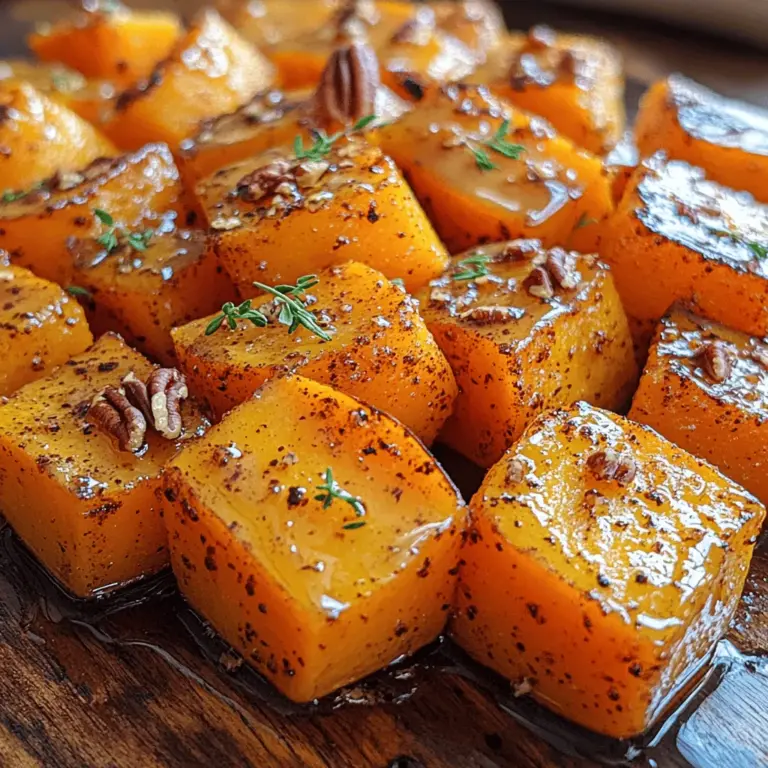Introduction to Maple Cinnamon Roasted Butternut Squash
Maple Cinnamon Roasted Butternut Squash is a delectable and visually stunning dish that embodies the essence of fall and winter. This recipe combines the natural sweetness of butternut squash with the warm, comforting flavors of maple syrup and cinnamon. The result is a side dish that not only enhances the aesthetic of your dining table but also tantalizes the taste buds, making it a perfect accompaniment to holiday feasts, cozy family dinners, or any occasion where you want to impress your guests.
As the leaves turn to vibrant shades of orange and gold, butternut squash becomes a staple in many kitchens. Its rich, nutty flavor pairs beautifully with a variety of dishes, from roasted meats to hearty grain bowls. The aromatic spices and the sweet drizzle of maple syrup elevate this humble vegetable into a sophisticated side that can complement both casual and formal meals.
Moreover, butternut squash is more than just a pretty face on your plate; it boasts numerous health benefits that make it a smart choice for any meal. Rich in essential vitamins and antioxidants, this squash is not only delicious but also a powerhouse of nutrition. As we delve deeper into the cooking process, you will discover how easy it is to prepare this delightful dish that resonates with the flavors of the season.
Understanding Butternut Squash
Nutritional Benefits of Butternut Squash
Butternut squash is a nutritional powerhouse, packed with vitamins and minerals that contribute to a balanced diet. It is especially rich in vitamins A and C, both of which play vital roles in maintaining a healthy immune system and promoting good vision. A single serving of butternut squash can provide more than 100% of the daily recommended intake of vitamin A, making it an excellent choice for those looking to improve their eye health or boost their immune defenses.
In addition to vitamins, butternut squash is a great source of fiber, which aids in digestion and helps to maintain a healthy gut. This fiber content can also promote feelings of fullness, making it a fantastic option for those watching their weight. The low calorie yet high nutrient density of butternut squash makes it an ideal ingredient for those looking to enjoy flavorful dishes without the guilt.
Moreover, butternut squash contains a variety of antioxidants, including beta-carotene and various phenolic compounds, which have been linked to reduced inflammation and a lower risk of chronic diseases. Incorporating this vibrant vegetable into your diet is not just a treat for the palate; it also supports overall health and well-being.
Culinary Versatility
One of the most appealing aspects of butternut squash is its culinary versatility. It can be used in a myriad of dishes, ranging from soups and stews to salads and casseroles. The slightly sweet and nutty flavor of this squash lends itself well to both savory and sweet applications, making it a favorite among chefs and home cooks alike.
In addition to roasting, butternut squash can be pureed for soups, blended into smoothies for added creaminess, or even used in baking to enhance the moisture and flavor of muffins and breads. Popular dishes featuring butternut squash include creamy butternut squash soup, risottos, and pasta sauces, showcasing its ability to shine in various cuisines.
This versatility allows you to experiment and get creative in the kitchen. Whether you’re looking to create a comforting fall dish or a light summer salad, butternut squash can effortlessly adapt to your culinary needs.
Key Ingredients for Maple Cinnamon Roasted Butternut Squash
To prepare Maple Cinnamon Roasted Butternut Squash, you will need a few essential ingredients. Understanding the role of each ingredient will help you create the most flavorful and nutritious dish possible.
Butternut Squash: Selection Tips and Preparation
When selecting butternut squash, look for a firm, unblemished skin that is a deep, tan color. The squash should feel heavy for its size, indicating that it is ripe and full of moisture. Avoid any squash with soft spots or blemishes, as these can indicate spoilage.
To prepare butternut squash, start by cutting off the ends and then slicing it in half lengthwise. Scoop out the seeds using a spoon; you can save these seeds to roast later for a crunchy garnish. Once the seeds are removed, cut the squash into cubes, making sure they are roughly equal in size for even cooking. The flesh of butternut squash is dense, so use a sharp knife and take your time to ensure safety during preparation.
Olive Oil: Health Benefits and Alternatives
Olive oil is a key ingredient in this recipe, contributing to the overall flavor and texture of the roasted squash. Rich in monounsaturated fats, olive oil is known for its heart-healthy properties. It is also packed with antioxidants and anti-inflammatory compounds, making it a great choice for cooking.
If you prefer a different flavor profile, you can experiment with other oils such as avocado oil or coconut oil. However, keep in mind that these oils may impart different flavors to the dish. For a more robust taste, consider using a flavored olive oil, such as garlic-infused olive oil, to enhance the overall dish.
Pure Maple Syrup: Importance of Using Pure Syrup vs. Imitation
When it comes to sweetening your roasted butternut squash, pure maple syrup is the best option. Unlike imitation syrup, which is often made with high fructose corn syrup and artificial flavors, pure maple syrup is derived from the sap of sugar maple trees and is packed with natural flavors and nutrients. It contains minerals such as manganese, zinc, and calcium, making it a healthier sweetener choice.
Using pure maple syrup not only adds sweetness but also contributes depth and complexity to the dish. The caramelization that occurs during roasting enhances the natural sugars in the squash, resulting in a rich and satisfying flavor.
Spices: The Role of Cinnamon, Nutmeg, Sea Salt, and Black Pepper in Flavor Enhancement
The spices used in Maple Cinnamon Roasted Butternut Squash play a crucial role in elevating the overall taste. Cinnamon is the star of the show, providing warmth and sweetness that perfectly complements the squash. Nutmeg adds a hint of earthiness, while sea salt enhances the natural flavors of the ingredients. A dash of black pepper rounds out the spice mix, adding a subtle kick that balances the sweetness.
Feel free to experiment with other spices, such as ginger or allspice, to create your unique flavor profile. These spices not only enhance the taste but also bring additional health benefits, as many of them possess anti-inflammatory and antioxidant properties.
Optional Garnishes: Benefits of Nuts and Fresh Herbs for Texture and Flavor
While the primary ingredients create a delicious dish on their own, consider adding optional garnishes to elevate your Maple Cinnamon Roasted Butternut Squash even further. Chopped nuts, such as pecans or walnuts, provide a delightful crunch and additional healthy fats. They also contribute a nutty flavor that pairs beautifully with the sweetness of the squash.
Fresh herbs, like rosemary or thyme, can add a burst of freshness and a fragrant aroma that complements the roasted flavors. A sprinkle of herbs just before serving not only enhances the presentation but also boosts the overall taste.
Step-by-Step Instructions for Perfect Roasting
Preheating the Oven: Importance of Temperature in Roasting
Before you begin the roasting process, it’s essential to preheat your oven to ensure even cooking. A temperature of around 400°F (200°C) is optimal for roasting butternut squash, as it allows the squash to caramelize beautifully without becoming mushy. Preheating the oven also helps to create a crispy exterior while keeping the inside tender and flavorful.
Once the oven is heated, you can proceed with preparing your butternut squash for roasting. This step is crucial for achieving that perfect balance of tender, flavorful squash with a satisfying caramelized finish.
Preparing the Butternut Squash for Roasting
With the oven preheating, gather your cubed butternut squash and place it in a large mixing bowl. Drizzle the olive oil over the squash, ensuring that each piece is well-coated. The oil not only helps the squash to roast evenly but also enhances the flavors of the spices that will be added next.
Next, sprinkle the cinnamon, nutmeg, sea salt, and black pepper over the squash. Toss everything together until the squash is evenly coated with the oil and spices. This step is crucial for ensuring that every bite is bursting with flavor.
Once the squash is well-seasoned, spread it out in a single layer on a baking sheet lined with parchment paper. Avoid overcrowding the pan, as this can lead to steaming instead of roasting. If necessary, use two baking sheets to ensure adequate space for the squash to cook evenly.
Following these steps will set you on the path to creating a delicious and visually appealing dish that highlights the best flavors of butternut squash. As you continue with the roasting process, you’ll soon see how simple ingredients can come together to create a memorable culinary experience that celebrates the essence of the season.

Preparing the Butternut Squash
To create a delicious Maple Cinnamon Roasted Butternut Squash, the first crucial step is preparing the squash itself. Butternut squash has a tough exterior, making it tricky to peel and cut without the right technique. Start by selecting a firm, heavy squash with a smooth, unblemished skin.
Peeling the Squash: Use a sharp vegetable peeler to remove the skin. It’s helpful to cut off both ends of the squash first, which stabilizes it for peeling. Make sure to apply even pressure to avoid slipping. An alternative method is to roast the squash whole for about 20 minutes to soften the skin slightly before peeling, making it easier to work with.
Cutting the Squash: Once peeled, place the squash upright on a cutting board. Cut it in half lengthwise, then scoop out the seeds with a spoon. For even cooking, chop the squash into uniform cubes, about 1-inch in size. This ensures that every piece roasts evenly, resulting in tender and caramelized bites.
Creating the Maple-Cinnamon Coating
The next step is to prepare the flavorful maple-cinnamon coating that brings the dish to life. The key to achieving the right consistency is balancing the maple syrup with the right amount of cinnamon and oil.
Ingredients for the Coating: Combine 1/4 cup of pure maple syrup, 2 tablespoons of olive oil, and 1 teaspoon of ground cinnamon in a small bowl. The maple syrup serves as the sweet base, while the olive oil helps the squash caramelize beautifully in the oven.
Mixing for the Right Consistency: Whisk the ingredients together until smooth. If the mixture feels too thick, you can add a teaspoon of water to thin it out slightly, ensuring it coats the squash evenly. The goal is to achieve a syrupy consistency that clings to the squash without being overly runny.
Ensuring Even Coating
To ensure each piece of squash is evenly coated with the maple-cinnamon mixture, proper tossing techniques are essential.
Tossing the Squash: In a large bowl, combine the cubed squash with the maple-cinnamon coating. Use a spatula or your hands to gently toss the squash, ensuring each piece is fully coated. Avoid overmixing, which can cause the squash to break apart. If you prefer a more hands-on approach, you can spread the squash on a baking sheet and drizzle the coating over the top before tossing it directly in the pan.
Roasting Tips
Roasting butternut squash to perfection involves a few key techniques to achieve that desired caramelization and tenderness.
Oven Temperature: Preheat your oven to 400°F (200°C). This temperature strikes the right balance between cooking the squash through and caramelizing the sugars for a delightful flavor.
Baking Sheet Preparation: Line a baking sheet with parchment paper for easy cleanup and to prevent the squash from sticking. Spread the coated squash in a single layer, leaving space between the pieces. This allows the hot air to circulate around each piece, promoting even roasting.
Monitoring for Doneness: Roast the squash for about 25-30 minutes, flipping the pieces halfway through the cooking time. The halfway stir is essential for ensuring even roasting, allowing both sides to caramelize beautifully. You’ll know the squash is done when it’s fork-tender and has developed a golden-brown color.
Significance of Stirring Halfway Through
Stirring the squash halfway through the roasting process is crucial for achieving uniform cooking. This step allows any pieces that may be browning faster to be rotated, ensuring that all sides get the same exposure to heat. It also prevents sticking and enhances the caramelization process, leading to a more flavorful dish.
Serving Suggestions and Pairings
Once your Maple Cinnamon Roasted Butternut Squash is perfectly roasted, it’s time to consider how to serve it.
Ideal Pairings: This dish pairs beautifully with a variety of main courses. Consider serving it alongside roasted chicken or turkey for a comforting meal. It can also complement vegetarian options like quinoa-stuffed peppers or lentil salad. The sweetness of the squash balances well with savory flavors, making it versatile for many dishes.
Suggested Main Dishes and Sides: For a complete meal, serve the roasted squash with grain-based sides such as wild rice or farro. A fresh arugula salad with a light vinaigrette can add a refreshing touch, contrasting delightfully with the sweetness of the squash.
Presentation Ideas: For an elegant presentation, serve the roasted squash in a large bowl garnished with fresh herbs like parsley or sage. You can also sprinkle toasted pumpkin seeds over the top for added texture and flavor.
Creative Serving Options: Consider using the roasted squash as a filling for tacos or as a topping for pizza. It can also be blended into soups for a creamy texture or added to grain bowls for a nutritious boost. During holiday gatherings, serve it as part of a festive platter alongside other seasonal vegetables for a colorful display.
Health and Nutrition Insights
Maple Cinnamon Roasted Butternut Squash is not only delicious but also nutritious, making it a perfect addition to a healthy diet.
Nutritional Information: Each serving of this dish (about 1 cup) contains approximately 100 calories, 0.5g of fat, 25g of carbohydrates, and 2g of protein. Butternut squash is rich in vitamins A and C, potassium, and fiber, making it a powerhouse of nutrients.
Benefits of Seasonal Produce: Incorporating seasonal produce like butternut squash into meals offers numerous health benefits. It is high in antioxidants and can help boost immunity, improve vision, and promote digestive health. Eating seasonal foods also supports local farmers and reduces the environmental footprint associated with food transportation.
Dietary Considerations: This dish is naturally vegan and gluten-free, making it suitable for various dietary needs. For those following a low-sugar diet, consider reducing the amount of maple syrup or substituting it with a sugar-free sweetener.
Potential Modifications: If you or your guests have specific dietary restrictions, you can easily modify this recipe. For example, adding spices like nutmeg or ginger can enhance the flavor profile. Substitute olive oil with coconut oil for a different taste. Additionally, for a richer flavor, consider adding a sprinkle of cheese, such as feta or goat cheese, before serving.
Conclusion: Embracing Seasonal Flavors with Maple Cinnamon Roasted Butternut Squash
The Maple Cinnamon Roasted Butternut Squash is a delightful dish that celebrates the flavors of fall. Its sweet, caramelized exterior combined with the warm spices makes it a comforting addition to any meal. Not only is it easy to prepare, but it also packs a nutritional punch, making it an excellent choice for health-conscious eaters.
Encouraging readers to try this recipe allows for creativity in the kitchen. Experimenting with variations by adding different spices or serving it in unique ways can elevate your culinary experience. Embracing seasonal ingredients not only enriches your meals but also fosters a deeper connection to the food you prepare and share with loved ones. So, gather your ingredients, unleash your inner chef, and enjoy the warmth and joy that comes from creating and sharing this delicious dish.

